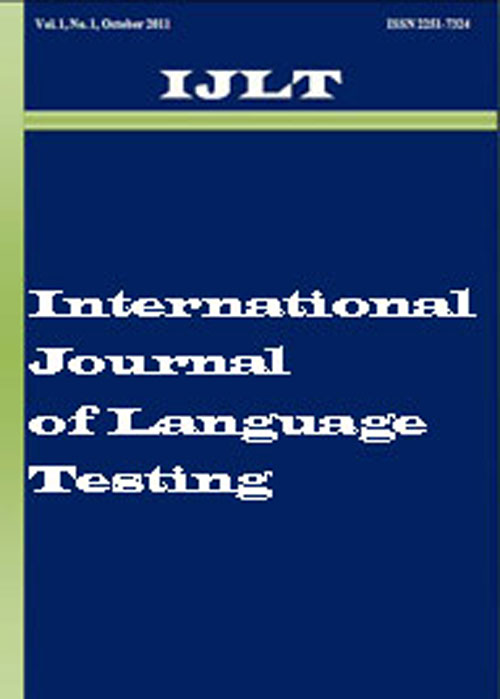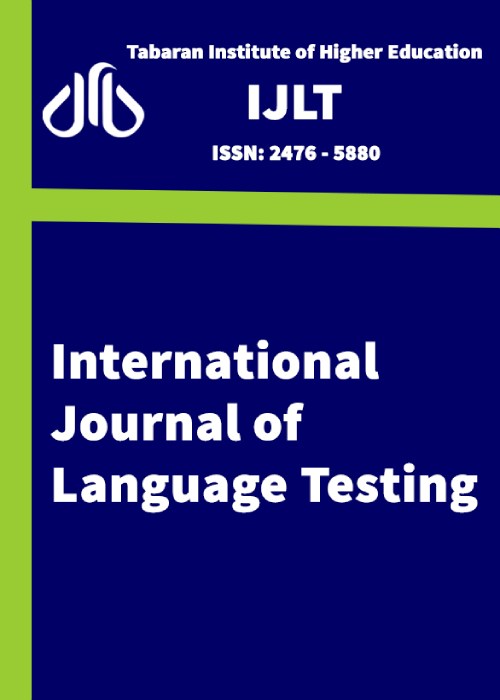فهرست مطالب

International Journal of Language Testing
Volume:8 Issue: 1, Mar 2018
- تاریخ انتشار: 1398/01/26
- تعداد عناوین: 3
-
Learners’ Attitudes toward Using Dynamic Assessment in Teaching and Assessing IELTS Writing Task OnePages 1-11Regarding the importance and complexity of writing among the EFL language learners, this study explored the learners’ attitudes toward teaching and testing writing through Computerized Dynamic Assessment (CDA). The participants of this study were 22 Iranian upper-intermediate EFL learners. All the participants were adults and participated in this study voluntarily. To meet the aim of the study, the researchers developed software which contained 11 series of multiplechoice questions tests. Throughout each test, participants received feedback based on their needs and within their Zone of Proximal Development (ZPD). After each session and test, the learners were required to write down their attitudes toward the effectiveness of CDA in teaching and testing writing. The participants wrote their attitudes in a form of diary. At the end, their diaries were analyzed and it was revealed that all the learners had positive attitudes toward the implementation of CDA in teaching writing.Keywords: Attitude, CDA, Writing, ZPD
-
Pages 12-26Test method is deemed to affect test scores along with examinee ability (Bachman, 1996). In this research the role of method facet in reading comprehension tests is studied. Bachman divided method facet into five categories, one category is the nature of input and the nature of expected response. This study examined the role of method effect in the Iranian University Entrance Exam (UEE). Research showed the current test method of assessing reading can highly impact test takers‟ performance and thereby examinees‟ test scores. Hence, different test formats may extract various traits and therefore, contaminate test scores and threaten validity. The researchers using exploratory factor analysis (EFA) extracted a second method factor in the reading comprehension section of the UEE which is composed of a multiple-choice cloze passage and multiple choice questions based on sustained texts. Results of the analysis showed that cloze test can create construct-irrelevant method variance, contaminating test scores, and led to violation of the unidimensionality assumption of the test.Keywords: Cloze Test, Exploratory Factor Analysis, Method Bias, Reading Comprehension Ability, Unidimensionality Assumption
-
Pages 27-32The handbook of second language assessment is a part of a long-lasting series called handbooks of applied linguistics. It has been published by De Gruyter Mouton since 1990s. Since that time, the field applied linguistics has gone through different ups and downs concerning the essence of the field. A hot debate was started by the experts involving in the field in which they sought the response to the essence of applied linguistics: Is it a disciplinary, interdisciplinary, or multidisciplinary field? The authors of different volumes went through the epistemological concepts of applied linguistics to frame their series. That said, they have established a programmic perspective toward applied linguistics in which they have searched solutions for the real world’s language and communication problems. This viewpoint can also be seen through the chapters of this handbook of second language assessment. In their introductory chapter on the handbook of second language assessment Karlfried Knapp and Gert Antos go through the distinction of “pure” and “applied” sciences. They state that due to the critical and reflecting nature of science to solve problems, we deal with the “applied” version of it to answer our world’s problems. However, from the very time we stick to the “applied” science, we encounter the question raised to investigate the role of sciences in a range of problems: from individual to interpersonal and social; moreover, from intercultural to political problems. This conception is the backbone of the current book. The chapter goes with several distinctions such as that of theoretically applied linguistics versus practically applied linguistics. The authors of this chapter, later on, state the objectives of the applied linguistics series; paving the ground for why it is necessary to have a handbook on second language assessment.


